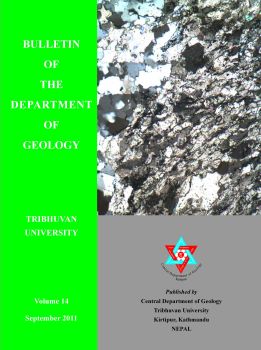Palynological assemblages from the Late Pleistocene sediments of the Patan Formation in Kathmandu Valley and their climatic implications
DOI:
https://doi.org/10.3126/bdg.v14i0.5440Keywords:
Palynology, Meliaceae, Oleaceae, Ericaceae, Poaceae, Compositae, Caryophyllaceae, Chenopodiaceae, Apiaceae, DipsacaceaeAbstract
Palynological investigation of ten samples obtained from a drill core belonging to the Late Pleistocene deposits of the PatanFormation in the Kathmandu Valley revealed 40 plant species belonging to 22 families. The gymnosperms are represented byAbies, Picea, Pinus spp. (P. roxburghii and P. wallichiana) and Tsuga sp. The angiosperm tree and shrubs are represented bygenera Quercus (Q. semecarpifolia, Q. lanata, Q. leucotricophora and Q. lamellosa and Q. glauca), Castanopsis, Alnus, Betula,Carpinus, Juglans, Myrica, Ulmus, Ilex, Strobilanthes, Elaeagnus and families Meliaceae, Oleaceae, Ericaceae, Poaceae,Compositae, Caryophyllaceae, Chenopodiaceae, Apiaceae, and Dipsacaceae. Similarly the wetland and aquatic plants arerepresented by Polygonun, Myriophyllum and Trapa. The presence of significant number of pteridophytes indicates humid anddamp environment at the periphery of the lake and surrounding forest floor. The pollen assemblage suggests that the PatanFormation was deposited under humid subtropical climate except at the middle part which indicates of warm temperate climaticcondition. The result obtained from the recent surface samples analysis and its comparison with fossil assemblages show thatmodern pollen spectra are not different with the fossil assemblages. This justifies that the fossil palynomorphs are local and itdenies the influence of exotic pollen.
DOI: http://dx.doi.org/10.3126/bdg.v14i0.5440
Bulletin of the Department of Geology Vol.14 2011, pp.59-66
Downloads
Downloads
How to Cite
Issue
Section
License
© Central Department of Geology, Tribhuvan University, Nepal

